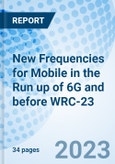How Will WRC-23 Shape the Future Spectrum Landscape for 5G and 6G?
The World Radiocommunication Conference 2023 (WRC-23), to be held in Dubai in November 2023, represents a pivotal international event focused on the allocation of frequencies and effective spectrum management.
This report helps to outline the key issues and discussions surrounding International Mobile Telecommunications (IMT) at WRC-23. It also highlights the importance of spectrum allocation for mobile technologies. In addition, the document examines spectrum requirements for 5G and emerging 6G networks. In particular, it highlights the need for additional mid-band spectrum, harmonised bands, and addresses the geopolitical dimensions associated with spectrum allocation.
Key Questions Answered:
- What are the key IM-related issues and discussions at WRC-23?
- What are the expected spectrum requirements to meet the growing demands of advanced 5G and 6G networks?
- What are the main frequency bands being considered for identification and allocation at WRC-23, and what are their characteristics and potential benefits and challenges?
- How have the results of previous conferences, such as WRC-19, impacted on spectrum allocation by national governments since then?
Table of Contents
Executive summary
1. Introduction
- The vital role of radio spectrum in mobile technology
- Evolution of mobile technologies and frequency bands
- Growth in mobile data traffic
2. Presentation of WRC-23 and spectrum for 5G use
- Objectives of WRC-23
- Frequencies for 5G Advanced and 6G
- Mid-band volume required for 5G Advanced and 6G
- Frequency bands needed for 5G
- Frequency bands needed for 5G Advanced
- Frequency bands needed for 6G
3. What are the target bands?
- Mid-band adoption since the start of 5G
- Overview of 3.5-.8 GHz bands characteristics
- Adoption landscape in the 3.5-3.8 GHz bands
- Overview of 5-6 GHz bands characteristics
- Adoption landscape in the 5-6 GHz bands
- Other bands: Overview of 7-20 GHz band characteristics
- Adoption landscape in the 7-20 GHz bands
- Other frequency bands: Sub-THz bands 4800-4990 MHz, 5925/6425-7125 MHz
- Adoption landscape for sub-THz GHz bands
- Other frequency bands: Overview of characteristics of sub-1 GHz bands
- Adoption landscape for sub-1 GHz bands
4. Conclusion
- WRC-23 focus: mid bands
- WRC-19 focus: mmWave bands
Samples

LOADING...
Methodology

LOADING...








